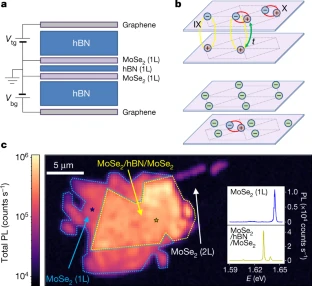Science Daily October 22, 2021
Recently engineered stacks of two-dimensional materials have emerged as a powerful platform for studying quantum correlations between electronic states. However, the strength of the interaction between the quantum states is typically fixed once a stack is fabricated. An international team of researchers (Switzerland, Japan) demonstrated that they can induce Feshbach resonance in their system allowing to tune the interaction strength between quantum entities by bringing them into resonance with a bound state. In their case the bounds states were between an exciton in one layer and a hole in the other layer. It turns out that when exciton and hole overlap spatially, the latter can tunnel to the other layer and form an inter-layer exciton-hole ‘molecule’. The relevant inter-layer interaction strength of the exciton-hole interactions can be readily changed using electric fields. The ‘tuning knob’ might become a versatile tool for a broad range of solid-state platforms based on 2D materials opening for experimental exploration of quantum many-body systems…read more. TECHNICAL ARTICLE 1 , 2

Device structure and basic characterization. Credit: Nature volume 580, pages472–477 (2020)